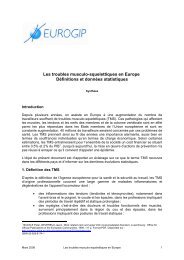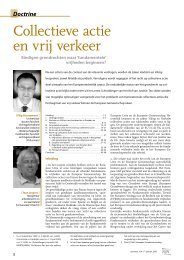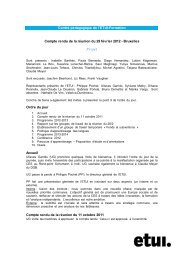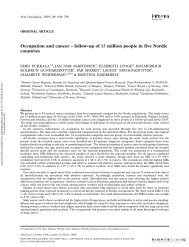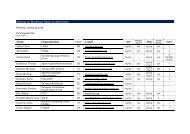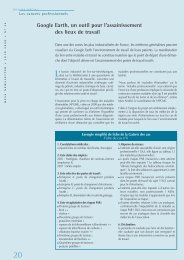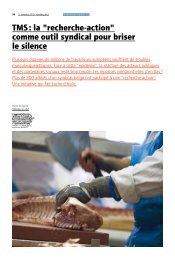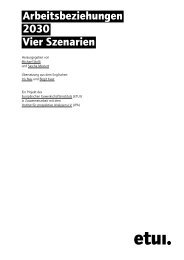Who earns minimum wages in Europe - European Trade Union ...
Who earns minimum wages in Europe - European Trade Union ...
Who earns minimum wages in Europe - European Trade Union ...
You also want an ePaper? Increase the reach of your titles
YUMPU automatically turns print PDFs into web optimized ePapers that Google loves.
François Rycx and Stephan Kampelmann<br />
<strong>wages</strong>, <strong>in</strong>clud<strong>in</strong>g exist<strong>in</strong>g sub-m<strong>in</strong>ima. The coverage of the database is much<br />
broader compared to both the OECD and Eurostat: the ILO database <strong>in</strong>cludes<br />
all 100 ILO member countries, i.e. also the countries <strong>in</strong> which <strong>m<strong>in</strong>imum</strong><br />
<strong>wages</strong> are set through collective agreements at the sub-national level (such as<br />
<strong>in</strong> Austria, Germany, or Italy). A drawback of the ILO data is that its last<br />
update dates back to September 2006.<br />
Next, the Hans-Böckler-Stiftung ma<strong>in</strong>ta<strong>in</strong>s an extensive database on<br />
<strong>m<strong>in</strong>imum</strong> <strong>wages</strong> 5 via the Wirtschafts- und Sozialwissenschaftliches Institut<br />
(WSI). This database not only monitors the development of <strong>m<strong>in</strong>imum</strong> <strong>wages</strong><br />
<strong>in</strong> Germany tariff sectors, but also provides regular updates on levels of<br />
<strong>m<strong>in</strong>imum</strong> <strong>wages</strong> for many <strong>Europe</strong>an and non-<strong>Europe</strong>an countries.<br />
F<strong>in</strong>ally, the <strong>Europe</strong>an Industrial Relations Observatory 6 publishes regular<br />
country reports with qualitative <strong>in</strong>formation on labour market <strong>in</strong>stitutions.<br />
These reports typically <strong>in</strong>clude sections on national <strong>m<strong>in</strong>imum</strong> wage systems<br />
<strong>in</strong> which the mechanisms for fix<strong>in</strong>g and revis<strong>in</strong>g wage floors are described by<br />
the Observatory's country experts.<br />
In sum, exist<strong>in</strong>g databases conta<strong>in</strong> statistical <strong>in</strong>formation on the bite of<br />
<strong>m<strong>in</strong>imum</strong> <strong>wages</strong> at the aggregate, national level. At the same time, they have<br />
numerous limitations: they fail to provide statistical <strong>in</strong>formation for countries<br />
with sub-national <strong>m<strong>in</strong>imum</strong> <strong>wages</strong>; they only conta<strong>in</strong> Kaitz <strong>in</strong>dices that do not<br />
adjust for exist<strong>in</strong>g sub-m<strong>in</strong>ima, the impact of the tax system, or cross-country<br />
differences <strong>in</strong> the composition of <strong>m<strong>in</strong>imum</strong>-wage earners; and, importantly,<br />
they do not allow to assess neither the employment spike at or near the<br />
<strong>m<strong>in</strong>imum</strong> wage nor the shadow spike that corresponds to hypothetical<br />
<strong>in</strong>creases of the <strong>m<strong>in</strong>imum</strong> wage. In other words, these databases are useful to<br />
obta<strong>in</strong> a general impression of cross-country differences regard<strong>in</strong>g the bite of<br />
national statutory <strong>m<strong>in</strong>imum</strong> <strong>wages</strong>, but they are less apt to further our<br />
understand<strong>in</strong>g of the impact of other types of wage floors. Crucially, they do<br />
not allow to shed light on the characteristics of the affected populations.<br />
As a consequence of these limitations, exist<strong>in</strong>g studies on <strong>m<strong>in</strong>imum</strong> <strong>wages</strong><br />
earners typically use micro-data from labour force surveys to elucidate<br />
questions such as the size and composition of the employment spike around<br />
the <strong>m<strong>in</strong>imum</strong> wage (Dolado et al., 1996; Mach<strong>in</strong> and Mann<strong>in</strong>g, 1997;<br />
<strong>Europe</strong>an Commission, 1998; OECD, 1998; Neumark and Wascher, 2004;<br />
Funk and Lesch, 2006). These studies reveal significant with<strong>in</strong>-country<br />
variation <strong>in</strong> the bite of <strong>m<strong>in</strong>imum</strong> <strong>wages</strong>: Funk and Lesch (2006), for <strong>in</strong>stance,<br />
report that whereas the 2004 <strong>m<strong>in</strong>imum</strong> wage <strong>in</strong> Lithuania represented only<br />
38 per cent of average <strong>wages</strong> <strong>in</strong> the economy as a whole, the <strong>m<strong>in</strong>imum</strong> wage<br />
<strong>in</strong> the Hotels and Restaurants Sector was as high as 61 per cent of average<br />
<strong>wages</strong> <strong>in</strong> that sector. Similarly, <strong>in</strong> 2004 the Estonian Kaitz <strong>in</strong>dex was 34 per<br />
cent for the entire economy, but 67 per cent <strong>in</strong> the Retail Sector. The bite of<br />
5. A voivodship is an adm<strong>in</strong>istrative unit of the Polish state.<br />
6. http://www.eurofound.europa.eu/eiro/structure.htm<br />
22 Report 124




